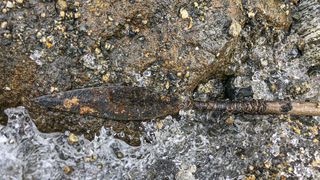Iron Age arrow found on Norway mountain still has feather fletching on it

A spectacularly preserved arrow from the Iron Age — complete with its iron arrowhead, sinew wrappings and aerodynamic feather fletching — is now in the hands of glacial archaeologists in Norway.
It's rare for arrow fletching to preserve, as the delicate feathers that help guide the arrow in flight usually decay over time. The arrows of Ötzi the Iceman, who died about 5,300 years ago in what is now the Italian Alps, also have preserved fletching, although their condition isn't as good as that of this newly discovered 1,700-year-old arrow, the archaeologists said.
"I think it is perhaps just the Ötzi-find which has preserved fletching on arrows, but his arrow fletchings are nowhere as well preserved as some of ours," Lars Pilø, an archaeologist at the Department of Cultural Heritage, Innlandet County Council, Norway, co-director of the Glacier Archaeology Program, told Live Science in an email.
However, "his are older too, by several thousand years, so this is not to diss Ötzi's arrows," Pilø said.
Related: Iron Age skis buried under ice reunited after 1,300 years apart
The archaeologists found the 31.5-inch-long (80 centimeters) arrow during a survey at an undisclosed site in the Jotunheimen mountains in southern Norway in 2019, the glacial archaeology group Secrets of the Ice announced on Twitteron April 28.
"It is probably the best preserved arrow we have found so far," said Pilø, who is also editor of the Secrets of the Ice website. For instance, the sinew, wrapped around the front end of the arrow shaft to reduce the risk of fracture on impact, is still "wrapped tightly" and in place, he said. The remains of the thread and tar used to craft the arrow are also present.
